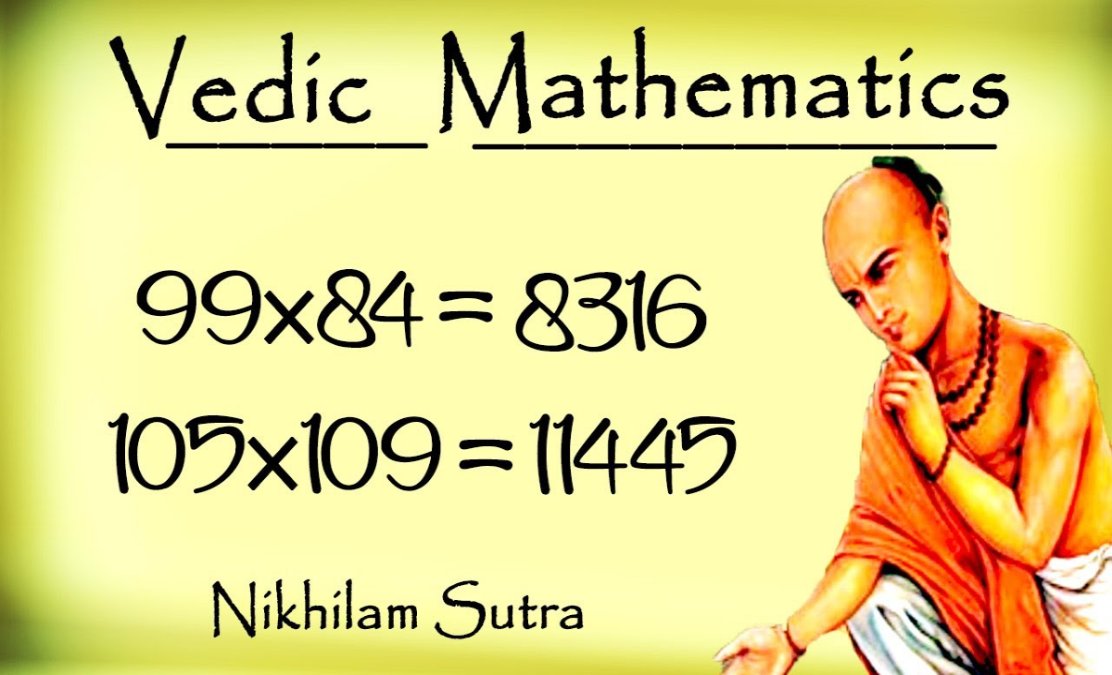Vedic maths
Vedic Maths

Vedic Mathematics is a book written by the Indian monk Bharati Krishna Tirtha, and first published in 1965. It contains a list of mathematical techniques, which were retrieved from the Vedas and containing of all mathematical knowledge.
Krishna Tirtha produced the sources, and scholars unanimously note it to be a compendium of tricks for increasing the speed of elementary mathematical calculations sharing similarities with historical mathematical developments during the Vedic period. However, there has been a proliferation of publications in this area and multiple attempts to integrate the subject into mainstream education by educated mathematicians and pro nationalism governments.
The book contains metaphorical aphorisms in the form of sixteen sutras and thirteen sub-sutras, which Krishna Tirtha states allude to significant mathematical tools. The range of their asserted applications spans from topic as diverse as statics and pneumatics to astronomy and financial domains. Tirtha stated that no part of advanced mathematics lay beyond the realms of his book and propounded that studying it for a couple of hours every day for a year equated to spending about two decades in any standardized education system to become professionally trained in the discipline of mathematics.
further leveraged that analytic geometry of conics occupied an important tier in Vedic mathematics, which runs contrary to all available evidence.
Vedic maths is a system of mathematics that was discovered by an Indian mathematician, Jagadguru Shri Bharathi Krishna Tirthaji during A.D. 1911 and 1918. He printed his findings in a Vedic Mathematics book – Tirthaji Maharaj. Vedic mathematics is also called mental mathematics in the mathematical world. We can say that the brain's capacity and its speed of calculations increases fivefold with the practice of Vedic maths.
Vedic Maths Meaning, History
Vedic Maths or Vedic Mathematics is a collection of Methods or Sutras to solve numerical computations quickly and faster. It consists of 16 Sutras called Formulae and 13 sub-sutras called Sub Formulae, which can be applied to the solving of problems in arithmetic, algebra, geometry, calculus, conics, etc. All the sutras and sub sutras of Vedic maths help to perform mathematical operations quickly and accurately.
Vedic Maths Sutras
The list of Sutras and Subsutras are tabulated below:
| S.No | Sutras | Sub-sutras |
| 1 | Ekadhiken Purvena | Anurupyena |
| 2 | Nikhilam Navatacharamam Dasatah | Sisyate Sesajnah |
| 3 | Urdhva-tiryagbhyam | Adyamadyenantya-mantyena |
| 4 | Paravartya Yojayet | Kevalaih Saptakam Gunyat |
| 5 | Sunyma Samyasamuchaye | Vestanam |
| 6 | (Anurupye) Sunyamanyat | Yavadunam Tavadunam |
| 7 | Sankalana-vyavakalamnabyam | Yavadunam Tavadunikrtya Varganca Yojayet |
| 8 | Puranapuranabhyam | Antyayoradaskaepi |
| 9 | Chalana-Kalanabhyam | Antyayoreva |
| 10 | Yavadunam | Samuccayagunitha |
| 11 | Vyastisamastih | Lopanasthapanabhyam |
| 12 | Sesanyankena Caramena | Vilokanam |
| 13 | Sopantyadvayamantyam | Gunitasamuccayah Samuccayagunitah |
| 14 | Ekanyunena Purvena | |
| 15 | Gunitasamuccayah | |
| 16 | Gunakasamuccayah |
Vedic Maths Benefits
The importance of Vedic Maths can be explained in various ways. The application of Vedic maths in the simplification of numerical problems is many times faster than the modern methods of calculations. Sometimes, this way of simplifying numerical calculations does not require paper and pen also. Thus, learning Vedic maths saves time and improves the interest in learning more applications of maths. Some of the benefits of Vedic mathematics sutras are listed below:
- Calculations become easy and short.
- Simplifications can be done in less time.
- Students undergo less mental stress.
- Results obtained by sutra-based methods can be easily verified with normal procedures.
- The possibility of committing errors by students using these sutras is negligible
- The use of sutras helps students to improve their knowledge and interest in the subject of mathematics.
- Vedic maths helps to solve hard problems using mental calculation

